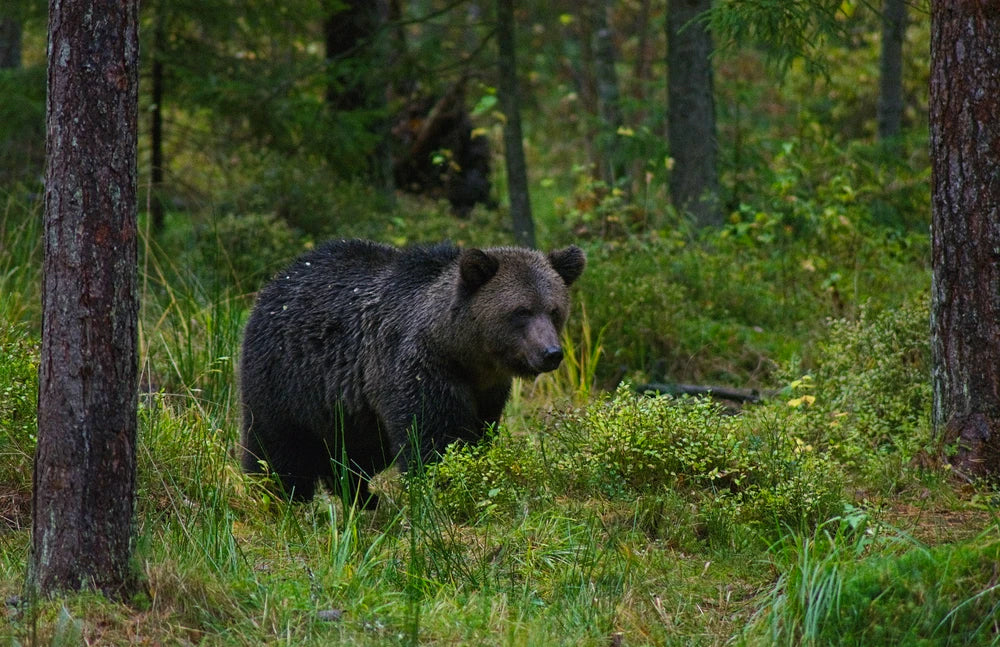How to shit in the woods (moors, mountains etc)

November's Adventurous Ink 'The Salt Path' is the inspiring tale of Raynor Winn and husband Moth who set out to walk the South West Coast Path, as they deal with a terminal illness and being made suddenly homeless.
Their story shows the miraculous power of repeatedly putting one foot in-front of the other, as they wild camp their way around the remote edge of England. It includes a telling moment early on as Raynor realises she needs to go: "I knew the moment would come. The moment when I'd have to face the big unanswered question: do bears shit in the woods?"
Let's just say Ray's approach to squatting behind a bush, then creating "an artistic wigwam of dead gorse" to cover her blushes is not the ideal way to relieve yourself outdoors. We asked seasoned wild camper and founder of Tirio Packrafting, Jason Taylor, to share how it should be done.

Stepping over the stile into the lush green woodland the group lift their eyes to the canopy above. Its a warm May evening and we’ve been walking and paddling since 9am. Tired now, they’ve been quiet since we dropped down from the mountains, but their silence is broken by a short intake of breath: woodlands always lift the spirits.

We drop our backpacks from aching shoulders for a well deserved pause before we make our wild camp. The glade is dappled with bluebells, they tinge the sylvan evening light. It a beautiful spot, hidden and undisturbed: that’s becoming a rarity in Snowdonia.
Once the tents are up I call the group over to talk about how we keep the woodland pristine - it is truly unspoilt, despite us camping here monthly over the summer season. We walk round the site, discussing techniques to minimise the ecological impact of our stay; the group are all ears and keen to learn.
The last topic we discuss is trickier, because at sometime during our stay someone will need to pee or crap. As we discuss the do's and don’ts I can see the tension on their faces. Its the same on every trip we run: crapping outdoors is something I’ve always found perfectly natural, but time and time again our adventurers tell me its a real obstacle to them wild camping.

It's not just putting them off, it's seriously off-putting. As visitor numbers in our wild spaces soar there has been an increase in inappropriate poop disposal - what were once unspoilt wildernesses - such as Sutherland and Caithness in the far North of Scotland, along with many bothies, are being plagued by crap - literally. With more people completing the North Coast 500 many folk are overnighting in lay-bys and just crapping; soggy loo roll flags line the roadsides and paths.

I’m seeing the same closer to home, in the Lakes and Wales. Popular wild camp spots like Sprinkling Tarn and Llyn Bochlwyd are dotted with crap, wipes and loo roll. Breaking down these barriers isn’t always easy, but a little application and a few pointers does help...
The correct disposal of human waste is essential to avoid pollution of water sources, avoid the impact of someone else finding it, minimise the spread of disease and maximise the speed of decomposition. In most places, burying human waste properly is the best method to do this.

In some locations, where there are higher number of visitors, I feel there is an increasing need to carry out the waste. And while there is an impact due to the need for single use plastics, sometimes it is definitely the better choice.
We’re trying to do better. For the last few years we’ve been educating all our Packrafting Expeditioneers on the best way to Crap in the Wilds and now on our Packraft Education Pathway we expect all our candidates to follow some simple rules to ensure we don’t negatively impact the wildernesses through which we travel.

Here’s a summary of the guidance we offer:
Cat Holes
Cat holes are the most common method of burying your crap, basically they’re a small hole dug into the organic layer of soil. Site your cat hole at least about 70 paces from water, paths and camp. Select a site where other people will be unlikely to go. With a small trowel, dig a hole 15-20 cm (6-8”) deep and 10-15 cm (4”-6”) across. Once you’ve pooped in the hole, cover it up with what you dug out of it and cover it over with natural materials to match the surroundings. If you’re in a group, disperse your cat holes around the area, don’t go in the same place twice. Rich dark organic soil is best as it speeds up the decomposition of your poop - although it can still take up to a year. Choose a place where water would not normally runoff after heavy rainfall. This helps to prevent it from getting into the water system.

WAG Bags
WAG or Waste Alleviating and Gelling Bags are commonly used in the USA in areas where human waste cannot be deposed of in the ground. They are a robust double bag system that you spread out on the ground and then you crap in the middle of it. Whilst they’re not designed to be pee’d into, a little urine is required to activate the neutralising and gelling agent. Once you’ve done the job - so to speak. You lift the outer of the bag and your poop drops down into the centre. Often a simple over hand knot is all that is required to seal the Poop bag before you drop it into the tough outer sack, so you’re no more exposed to the sight and smell of your crap than when you’re at home. They’re getting easier to find in the UK and can be found with a simple Google Search.
When and how to go
Squatting while you go can often feel a little uncomfortable if you need to stay there for a while. So my advice is always to wait until you’re really ready. Then by the time you’ve dug the cat hole you won’t need to wait long! Another problem people often encounter is balancing while they’re in the act. A simple trick is to collect a stout stick or branch approximately 60cm (2’) long and just push it into the ground a little in front of you when you squat. If nothing is to hand then you could use your trowel. This acts as something to hold and balance you while you go.
Last Minute Checks!
Right before you release be sure to check clothing is well out of the way and that your loo roll is really to hand.
Soft and strong
Only take plain, un-moistened, non-textured loo paper into the wilds. Once used it should be either, thoroughly buried in the cat hole or preferably packed out. Moist wipes for wiping are, in my opinion an unnecessary frivolity, but if they are used they must be packed out.
Tampons and Sanitary towels do not decompose and therefore must be wrapped and packed out. Do not bury them or burn them.
Packing it Out.
One solution is to carry an opaque plastic wide mouthed bottle with a screw top and some bio-degradable bags, wrap the items in the bag, tie the bag and place it in the container. I’ve used this method in the USA a lot and more and more in the UK in recent years. I’ve never had a WAG Bag split and there’s very little, if any smell due to the gelling agent, the containers act as our rubbish bin for any trip and so there is very little bulk or weight penalty. We found that asking local restaurant will generally turn up a suitable container - we find that one with a litre capacity is suitable for a couple over a weekend trip. Be sure to label the container clearly!! When you get home you can dispose of the contents it in your rubbish, but I always put it in an extra bag first, just to be sure.

Start em young
We have 2 kids and although they’re older now they’ve been wild camping since they were tots. We’ve always found that younger kids often don’t have any inhibitions about going outdoors - although they do need an adult to help them dig, balance and help with the tidy up. Older kids and teens can find it a little more challenging but if we explain the how tos then they’re no more reluctant than an adult.
Hygiene
It goes without saying that washing your hands after you go is essential. For me it has to be immediately after going to the loo and immediately before food or water prep. To that end I always carry alcohol sanitising gel in my loo kit and more in my food prep kit.

Dont hold back
Holding it in is a really bad idea. Holding back from taking a pee in the wilds can not only cause a lot of discomfort but also, if done repeatedly or for long enough can increase your chance of getting a urinary tract infection due to the build up of bacteria. Often more likely in females, anyone who’s had a UTI will tell you you don’t want one! On longer trips you really run the risk of fever and more severe complications.
Clinging on to your poop is equally unwise. After a while you bowels can become desensitised to the poop in there and this will lead to a backing up of additional material. As we're often dehydrated in the outdoors while exercising, liquid can be reabsorbed from the bowel, firming up the problem even more. Before too long a Feacal Impaction can occur, this hard lump of poop is impossible to pass and will require a visit to a Doc to extract it. Need I say more?
Poop Kit
My poop kit is in an old tent peg bag or similar, in it I carry:
- A small tough trowel.
- Alcohol hand sanitiser.
- Biodegradable food waste bags (the sort you use in you waste food caddy)
- Medium brown paper bags.
-
100% recycled loo paper
In addition - if I’m packing it out:
- WAG Bags.
- Waste Container - Opaque, wide topped, screw lid. (I use an old catering olive tub scrounged from a mate who runs a Cafe).
- A tough plastic bag.
So there you go; double entendres aside. I'm hearing, seeing and, more frequently recently, smelling the impact of increased use of our wild places. Happening across someone else's crap is guaranteed to spoil anyone's day.
There can be no doubt that crapping outside is the most natural way to go, after all Homosapiens (that’s you) have been around now for around 350,000 years. A little extra know how and equipment means that we can all experience the wilds without leaving our mark.

Excellent, thanks Jason. I'm sure we'll all go a little wilder thanks to your sage advice!
Tirio have a range of packrafting adventures available in the new year, many involving wild camps, including full days, overnights, accredited weekend courses even a five day expedition paddler course in the Highlands of Scotland (drop them an email for info on that).
Subscribers to Adventurous Ink get a 10% discount too.
Subscribe today and take 1/3 off by using the code FRESHINK at checkout.
Photo credits, used under CC Licence:
Bear - LH_4tography
Torridon - Steve Schnabel
